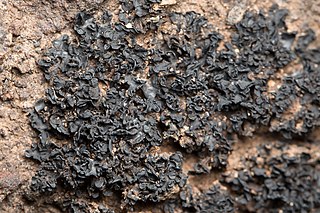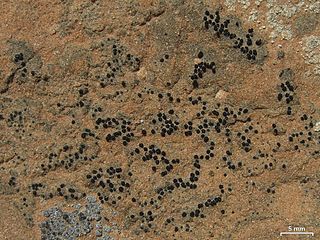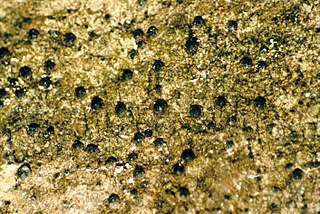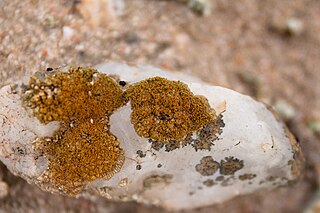
The Psoraceae are a family of lichenized fungi in the order Lecanorales. The Austrian Botanist and Lichenologist Alexander Zahlbruckner first described the family in 1898. Species of this family have a widespread distribution.

The Acarosporaceae are a family of fungi in the order Acarosporales. Members of this family have a widespread distribution, and are mostly lichenized with green algae. According to a 2021 estimate, the family contains 11 genera and about 260 species. The family is characterised by a hamathecium formed of paraphysoids.

The Lichinaceae are a family of ascomycete fungi. Most species are lichenized with cyanobacteria, and have a distribution largely in temperate regions.
Santessonia is a genus of lichenized fungi in the family Caliciaceae. The genus was circumscribed in 1978 by lichenologists Mason Hale and Gernot Vobis, with Santessonia namibensis assigned as the type species, and at that time, only species. This species, endemic to the Namib Desert, has deep depressions (lacunae) in the thallus, which are interpreted as an adaptation to take advantage of the infrequent moisture provided by fog. The genus name honours Norwegian lichenologist Rolf Santesson.

Staurothele is a genus of saxicolous (rock-dwelling), crustose lichens in the family Verrucariaceae. It has about 40 species. When the fungus is part of a lichen, the genus of lichen is commonly called rock pimples.

Flavoparmelia is a genus of foliose lichens in the family Parmeliaceae. Because of their appearance, they are commonly known as greenshield lichens. The widely distributed genus contains 32 species. It was circumscribed by American lichenologist Mason Hale in 1986 to contain 17 former Pseudoparmelia species with broad lobes, usnic acid in the cortex, and isolichenan in the cell walls.

Canoparmelia is a genus of lichen-forming fungi in the family Parmeliaceae. The widespread genus contains about 35 species. Canoparmelia, a segregate of the parmelioid lichen genus Pseudoparmelia, was circumscribed by John Elix and Mason Hale in 1986.
Zahlbrucknerella is a genus of filamentous, rock-dwelling lichens in the family Lichinaceae.

Peltula is a genus of small dark brown to olive or dark gray squamulose lichens that can be saxicolous ) or terricolous. Members of the genus are commonly called rock-olive lichens. They are cyanolichens, with the cyanobacterium photobiont from the genus Anacystis. They are umbilicate with flat to erect squamule lobes that attach from a central holdfast or cluster of rhizenes. Lichen spot tests are usually negative.
Eremastrella is a genus of lichen in the family Lecideaceae. The genus was circumscribed by lichenologist Stefan Vogel in 1955, with Eremastrella tobleri assigned as the type species.
Glyphopeltis is a genus in the family Psoraceae. It is monotypic, consisting of the single saxicolous lichen species Glyphopeltis eburina, found in southern Africa. This species was formally described as a new species in 1985 by Franklin Brusse, who discovered the type specimen growing on the shaded lower surface of a dolerite boulder in Cape Province.

The Lecideaceae are a family of lichens in the order Lecideales.
Hueidea is a single-species fungal genus in the family Fuscideaceae. It contains the species Hueidea australiensis, a saxicolous (rock-dwelling), crustose lichen found on granite rocks in the Mount Kosciuszko area of New South Wales, Australia. Both the species and the genus were described as new to science in 2003 by Australian lichenologists Gintaras Kantvilas and Patrick McCarthy.
Coelopogon is a genus of lichen-forming fungi in the family Parmeliaceae. The genus contains two species found in southern South America and South Africa.
Coronoplectrum is a single-species genus of unknown familial placement in the order Lecanorales. The only species in the monotypic genus is Coronoplectrum namibicum, a fruticose (bushy), saxicolous (rock-dwelling) lichen found in Namibia. The genus was circumscribed by Franklin Brusse in 1987.

Scoliciosporum is a genus of lichens in the family Scoliciosporaceae.
Kalbiana is a genus of saxicolous (rock-dwelling), crustose lichen of uncertain familial placement in the order Verrucariales. Both the genus and its only species, Kalbiana brasiliensis, were described in 1988 by lichenologist Aino Henssen. The genus name honours German lichenologist Klaus Kalb, while the species epithet refers to Brazil, where the lichen is found.
Aridoplaca is a fungal genus in the family Teloschistaceae. It is a monotypic genus, containing the single saxicolous (rock-dwelling) squamulose lichen species Aridoplaca peltata, found in South America. The genus was circumscribed in 2021 by Karina Wilk, Maciej Pabijan, and Robert Lücking, following molecular phylogenetic analysis that showed the species occupies a distinct lineage in the subfamily Xanthorioideae of the Teloschistaceae. The species epithet peltata refers to the squamulose and peltate thallus, while the genus name refers to the habitat of the lichen, which occurs in arid areas of Bolivia and Peru. It grows in well-lit areas on siliceous rocks at altitudes between 3,500 and 4,500 m.

Stellarangia is a genus of lichen-forming fungi in the family Teloschistaceae. It has three species of saxicolous (rock-dwelling), crustose lichens. Species of Stellarangia are found in dry, desert areas in Namibia and South Africa.









